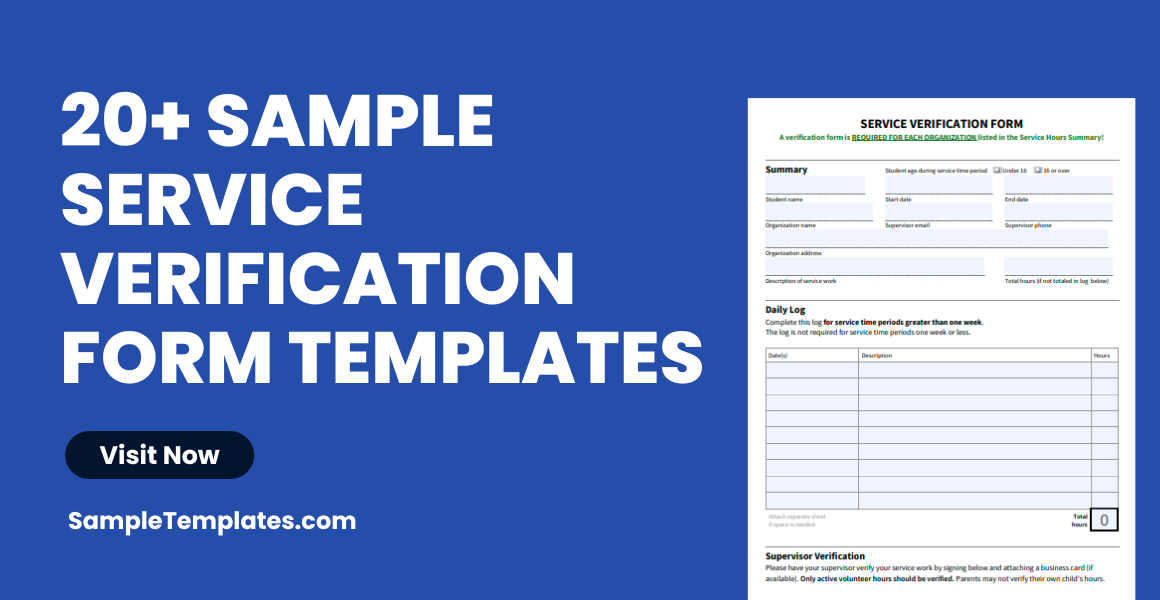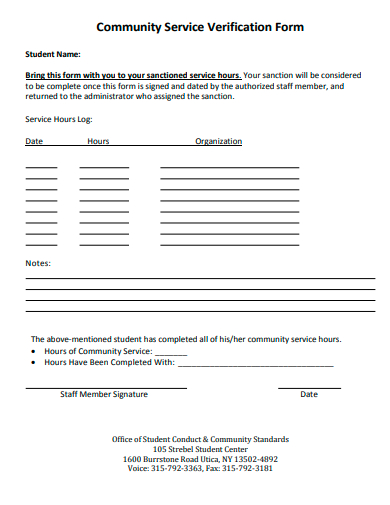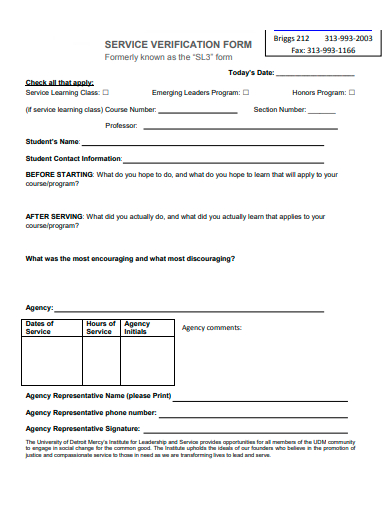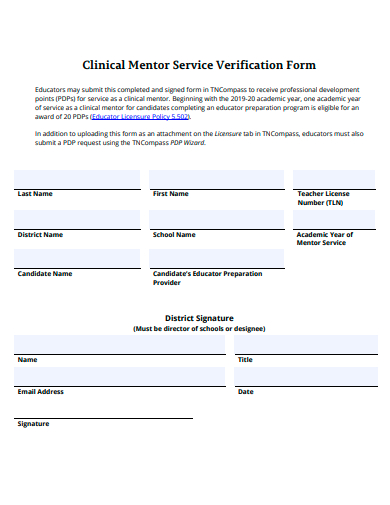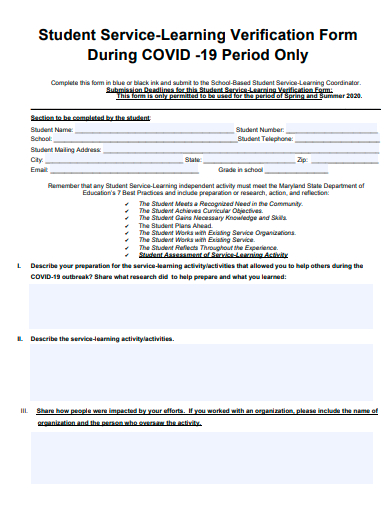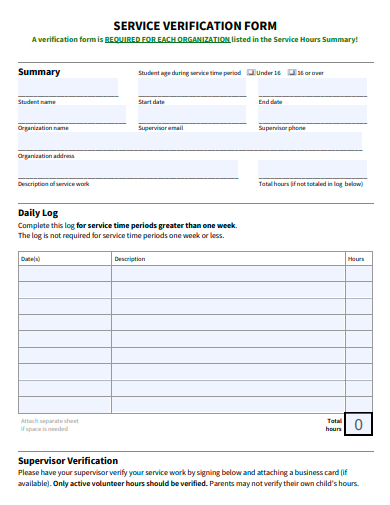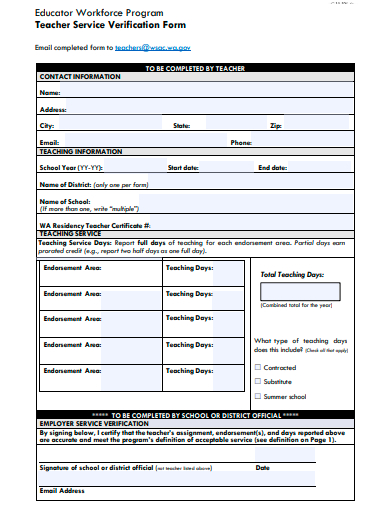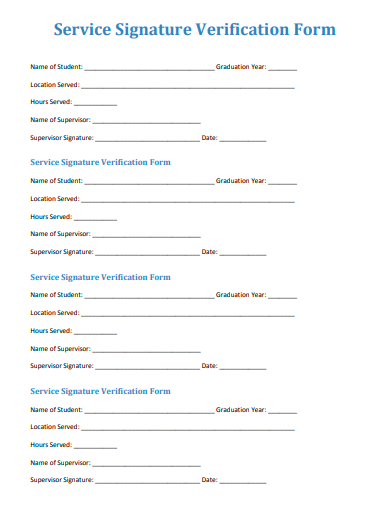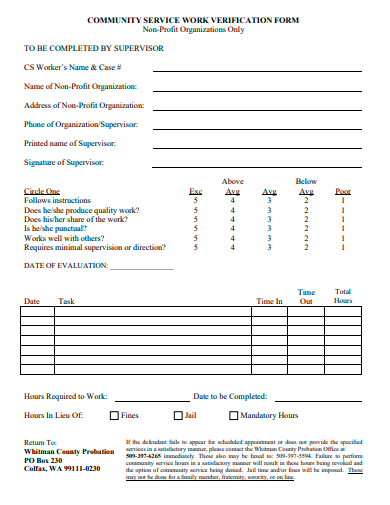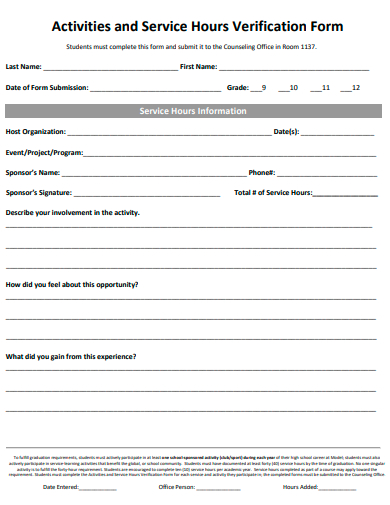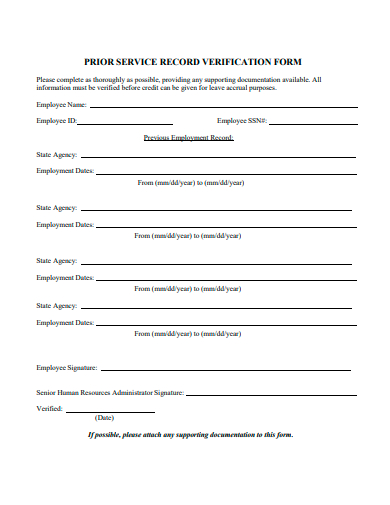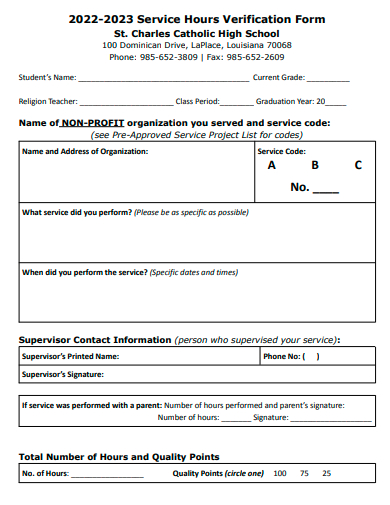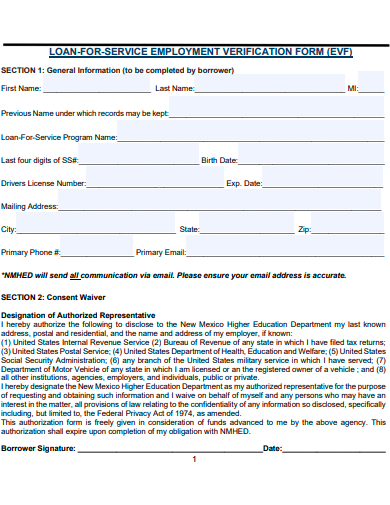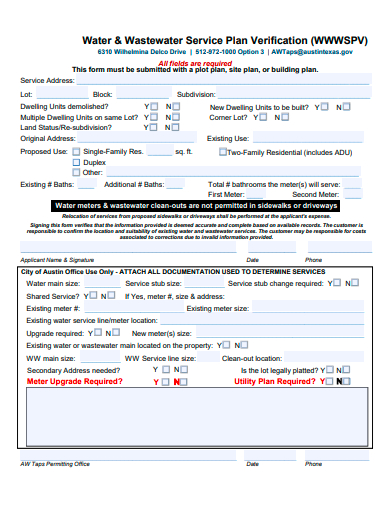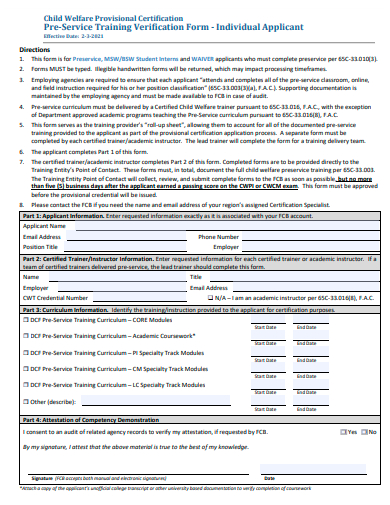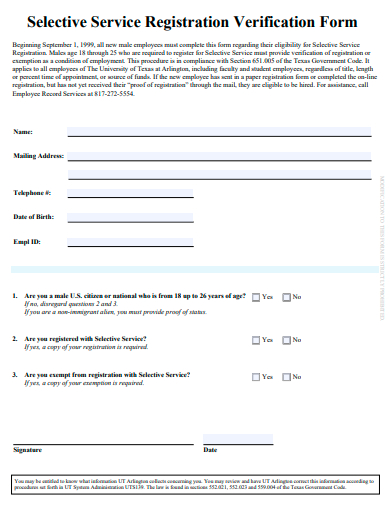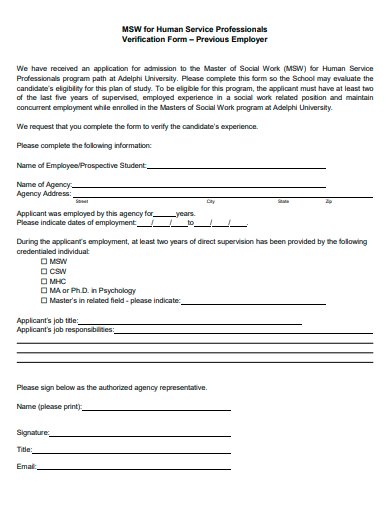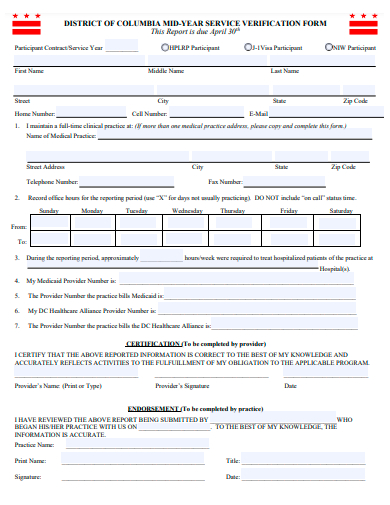Discover the ultimate service verification solution with our Service Verification Form Template. In a world where trust and authenticity are paramount, our user-friendly form empowers you to seamlessly verify service quality. This versatile tool allows you to collect vital information through our application form, enabling comprehensive validation. Bid farewell to uncertainty and embrace confidence in your service interactions. Start using our Service Verification Form Template today to ensure transparency, make informed decisions, and experience peace of mind in every service experience.
20+ Service Verification Form Samples
1. Volunteer Service Verification Form Template
2. Sample Community Service Verification Form Template
3. Service Verification Form Template
4. Clinical Mentor Service Verification Form Template
5. Student Service Learning Verification Form Template
6. Sample Service Verification Form Template
What Is a Service Verification Form?
A Service Verification Form is a crucial document or tool used in various industries to validate the authenticity and quality of services provided. It serves as a means to confirm that the services delivered meet specific criteria, standards, or contractual agreements. This form is designed to ensure transparency, accountability, and trust between service providers and their clients, customers, or regulatory bodies.
Key Components of a Service Verification Form:
Service Details: The form typically starts with spaces to capture essential information about the service being verified. This includes the type of service, service provider’s name, and the date or timeframe during which the service was rendered.
Service Recipient Information: To verify services effectively, the form may require details about the service recipient, such as their name, contact information, and any relevant identification or account numbers.
Service Specifications: This section outlines the specific criteria, specifications, or requirements that the service should meet. It can include details about the scope of work, performance standards, and any contractual obligations.
Verification Process: The form provides a step-by-step guide on how the verification process will be conducted. It may include a checklist of tasks, procedures, or assessments to ensure the service complies with the established standards.
Documentation: Verification often requires supporting documentation, such as invoices, receipts, sample reports, or photos. The form includes sections where these documents can be attached or referenced.
Signatures and Approvals: To formalize the verification process, the form includes spaces for authorized personnel to sign and approve the verification results. This adds a layer of accountability to the process.
Importance of Service Verification Forms:
Quality Assurance: Service verification forms are critical for maintaining service quality. They provide a structured process to confirm that services meet or exceed predefined standards.
Dispute Resolution: In case of disputes or discrepancies between service providers and recipients, these forms serve as documented evidence of the services provided, helping resolve conflicts.
Regulatory Compliance: In highly regulated industries like healthcare or finance, service verification is necessary to ensure compliance with industry standards and regulations.
Customer Confidence: For businesses, service verification forms can instill confidence in customers, as they demonstrate a commitment to delivering reliable and high-quality services.
Continuous Improvement: Feedback and findings from service verification forms can be used for process improvement. It helps service providers identify areas where they can enhance their offerings.
Types of Service Verification Forms:
Healthcare Service Verification Form: Used to confirm that medical services, treatments, or procedures have been provided correctly and in accordance with healthcare standards.
Financial Service Verification Form: Commonly used in the banking and financial industry to validate transactions, account activities, or financial services.
Construction Service Verification Form: Ensures that construction projects adhere to building codes, safety regulations, and contractual agreements.
Customer Service Verification Form: Used in call centers and customer service departments to assess the quality of service interactions.
Product Service Verification Form: For manufacturers and product providers, this form verifies that product-related services (e.g., repairs, maintenance) meet specified standards.
A Service Verification Form Sample is a valuable tool that plays a vital role in maintaining quality, transparency, and accountability in service delivery across various sectors. By documenting and confirming that services meet established standards, these forms contribute to building trust between service providers and their clients, ultimately leading to better customer satisfaction and confidence in the services offered.
7. Teacher Service Verification Form Template
8. Service Signature Verification Form Template
9. Community Service Work Verification Form Template
10. Sample Teaching Service Verification Form Template
11. Activities and Service Hours Verification Form Template
12. Service Record Verification Form Template
13. Service Hours Verification Form Template
How to Use our Service Verification Forms?
Utilizing service verification forms effectively is crucial to ensuring that services meet the expected standards and specifications. These forms streamline the process of confirming service quality, enhancing transparency, and fostering trust between service providers and recipients. Here’s a comprehensive guide on how to use service verification forms:
Understand the Purpose:
Before using a service verification form, it’s essential to comprehend its purpose. These forms are designed to verify and validate services to ensure they align with predefined criteria, standards, or contractual agreements. Knowing this fundamental purpose statement will guide you through the process.
Access the Relevant Form:
Begin by obtaining the appropriate service verification form. Depending on your industry and the nature of the service, these forms may be provided by regulatory bodies, organizations, or developed in-house.
Complete the Service Details:
Fill out the form with accurate and detailed information about the service being verified. This includes the service type, date of service, service provider’s details, and any other relevant specifics.
Gather Supporting Documentation:
Service verification often requires supporting documentation. Collect all necessary records, such as sample invoices, receipts, reports, or photographs, to substantiate the verification process.
Review the Service Specifications:
Refer to the section of the form that outlines the service specifications or criteria. This serves as a checklist to ensure that the service complies with the established standards.
Conduct the Verification Process:
Follow the verification process as outlined in the form. This may involve inspections, assessments, or tests to confirm that the service meets the required standards.
Attach Supporting Documents:
As you proceed with the verification, attach the relevant supporting documents to the form. These documents provide tangible evidence of the service’s quality and compliance.
Obtain Signatures and Approvals:
After completing the verification process, obtain the necessary signatures and approvals from authorized personnel. These signatures validate the verification results and confirm that the service has met the required standards.
Document Findings and Observations:
Use the form to document any findings, observations, or comments related to the service verification. This information can be invaluable for reporting, analysis, and improvement purposes.
Maintain Records:
Keep copies of the completed service verification forms and associated documents in an organized manner. Proper record-keeping ensures that you have a documented history of service quality and compliance.
Resolve Discrepancies and Issues:
In cases where the service does not meet the specified standards or discrepancies arise, take the necessary steps to address and resolve the issues. This may involve communication with the service provider and implementing corrective actions.
Use Data for Improvement:
Leverage the data collected through service verification forms for continuous improvement. Identify trends, areas of concern, and opportunities to enhance service quality and processes.
Communicate Results:
Share the verification results and findings with relevant stakeholders, including clients, customers, regulatory bodies, or internal teams. Transparency in communication builds trust.
Periodic Review:
Regularly review and update your service verification forms to ensure they remain aligned with industry standards and evolving service requirements.
The effective use of service verification forms is vital for maintaining and assuring service quality, compliance, and transparency. By following these steps and guidelines, organizations can ensure that services meet or exceed expectations, leading to enhanced customer satisfaction and confidence in the services provided.
14. Loan For Service Employment Verification Form Template
15. Sample Service Plan Verification Form Template
16. Pre-Service Training Verification Form Template
17. Basic Service Verification Form Template
18. Selective Service Registration Verification Form Template
19. Service Professionals Verification Form Template
20. High School Community Service Verification Form Template
21. Sample Mid Year Service Verification Form Template
What are the types of verification forms?
Verification forms come in various types and serve specific purposes across different industries and sectors. These forms are essential tools for confirming the authenticity, accuracy, or compliance of various processes, services, or information. Here are some common types of verification forms:
Service Verification Form:
Service verification forms are used to confirm that services provided meet specified criteria, standards, or contractual agreements. They are commonly utilized in industries such as healthcare, construction, and customer service to ensure the quality and authenticity of services.
Identity Verification Form:
Identity verification forms are designed to confirm the identity of individuals or entities. They play a crucial role in various processes, including financial transactions, government applications, and employment procedures, by ensuring that the identity provided is accurate and legitimate.
Document Verification Form:
Document verification forms are employed to verify the authenticity of documents, such as diplomas, certificates, or legal agreements. These forms are commonly used in educational institutions, legal offices, and government agencies to validate the legitimacy of important paperwork.
Employment Verification Form:
Employment verification forms are used by employers to verify a job applicant’s employment history. They typically include details about past positions, dates of employment, and salary history. These forms are essential during the hiring process and for conducting background checks.
Address Verification Form:
Address verification forms are designed to confirm an individual’s or organization’s current address. They are used by businesses, government agencies, and financial institutions to ensure accurate contact information.
Income Verification Form:
Income verification forms are employed to confirm an individual’s income, which is often required for loan applications or rental agreements. Financial institutions and real estate agencies commonly use these forms.
Background Verification Form:
Background verification forms are used to conduct comprehensive background checks on individuals. These checks may include criminal history, credit history, and employment history. Employers, landlords, and financial institutions frequently use these forms to make informed decisions.
Supplier Verification Form:
Supplier verification forms are used in supply chain management to assess and verify the authenticity, reliability, and compliance of suppliers. These forms are crucial in industries like manufacturing and procurement.
Customer Verification Form:
Customer verification forms are used to confirm the identity and authenticity of customers. They are employed in various industries, including banking, telecommunications, and e-commerce, to prevent fraud and ensure regulatory compliance.
Compliance Verification Form:
Compliance verification forms ensure that individuals or organizations adhere to specific regulations, policies, or industry standards. They are commonly used in healthcare, environmental compliance, and quality control.
Vehicle Verification Form:
Vehicle verification forms are used to verify the authenticity of vehicle information, such as the Vehicle Identification Number (VIN) or registration details. These forms are essential in the automotive industry and during vehicle sales.
Insurance Verification Form:
Insurance verification forms confirm insurance coverage and policy details for individuals or assets. Healthcare providers and insurance companies often use these forms to ensure accurate billing and coverage information.
Asset Verification Form:
Asset verification forms are used to verify the ownership and condition of assets, such as real estate or equipment. They are important in real estate transactions and asset management.
Loan Verification Form:
Loan verification forms are employed by lenders to verify an applicant’s financial information, creditworthiness, and eligibility for loans. These forms are crucial in the lending and mortgage industries.
Legal Verification Form:
Legal verification forms are used in legal proceedings to verify facts, claims, or statements made by parties involved. They are common in court cases and legal investigations.
Tax Verification Form:
Tax verification forms are used to verify tax-related information, including income, deductions, and tax credits. They play a vital role in tax compliance and audits.
Each type of verification form serves a specific purpose in confirming information, compliance, or authenticity within its respective domain. The use of these forms contributes to transparency, accountability, and trust in various processes and transactions.
Related Posts
Sample Sworn Affidavit Forms
Vehicle Inspection Forms Samples & Templates
Sample Employee Advance Forms
Sample Child Travel Consent Forms
Sample Testimonial Request Forms
Sample Employee Details Forms
Sample Divorce Forms
Sample Attestation Forms
Employee Performance Appraisal Form Templates
FREE 9+ Sample Presentation Evaluation Forms in MS Word
FREE 10+ School Admission Form Samples & Templates in MS Word | PDF
FREE 30+ Patient Consent Form Samples in PDF | MS Word
FREE 10+ Sample Sign Off Form Templates in PDF | MS Word
FREE 11+ Sample Medical Consultation Forms in PDF | MS Word
FREE 8+ Sample Donation Forms in PDF | MS Word
